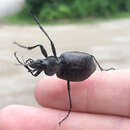Conservation Status
provided by University of Alberta Museums
Common.
- license
- cc-by-nc
- copyright
- University of Alberta Museums
Cyclicity
provided by University of Alberta Museums
Adults have been collected in May and June.
- license
- cc-by-nc
- copyright
- University of Alberta Museums
Distribution
provided by University of Alberta Museums
This species is wide ranging in both United States and Canada. In Alberta this species has been collected in the central regions.
- license
- cc-by-nc
- copyright
- University of Alberta Museums
General Description
provided by University of Alberta Museums
This species, in the subgenus Calosoma, is characterized by the small, short prothorax which, compared with the elytra, is pronouncedly narrow. Black, often with faint bronze lustre, sides of prothorax and elytral foveae and side margins usually metallic (green, golden or purple); ventral side with green or purple reflection; legs black. Length 17 to 27 mm.
- license
- cc-by-nc
- copyright
- University of Alberta Museums
Habitat
provided by University of Alberta Museums
This species may occur in all kinds of habitats, but apparently prefers open woodland.
- license
- cc-by-nc
- copyright
- University of Alberta Museums
Life Cycle
provided by University of Alberta Museums
Overwintering occurs in the adult stage. Adults readily climb trees in seach of caterpillars.
- license
- cc-by-nc
- copyright
- University of Alberta Museums
Trophic Strategy
provided by University of Alberta Museums
Predatory, particularly in the larval stage, specializing upon caterpillars and pupae of Lepidoptera.
- license
- cc-by-nc
- copyright
- University of Alberta Museums
Calosoma frigidum
provided by wikipedia EN
Calosoma frigidum, also known as the cold-country caterpillar hunter,[1] is a species of ground beetle in the subfamily Carabinae.[2] It was first described by William Kirby in 1837.[2] Occurring throughout southern Canada and the United States, it is about 16mm to 27mm long and black, with rows of pits or dots along its elytra. These pits are an iridescent blue/green, and larger than the pits of many other Calosoma species. It can be found in wooded areas and is active at night, while hiding under debris by day.[1]
References

- license
- cc-by-sa-3.0
- copyright
- Wikipedia authors and editors
Calosoma frigidum: Brief Summary
provided by wikipedia EN
Calosoma frigidum, also known as the cold-country caterpillar hunter, is a species of ground beetle in the subfamily Carabinae. It was first described by William Kirby in 1837. Occurring throughout southern Canada and the United States, it is about 16mm to 27mm long and black, with rows of pits or dots along its elytra. These pits are an iridescent blue/green, and larger than the pits of many other Calosoma species. It can be found in wooded areas and is active at night, while hiding under debris by day.
- license
- cc-by-sa-3.0
- copyright
- Wikipedia authors and editors

